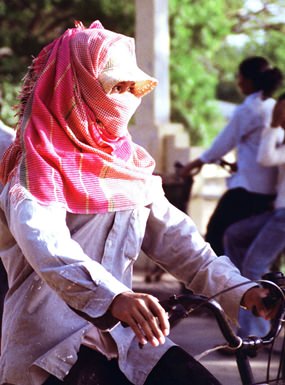In a couple of months, many of you will be gearing up for the annual overseas trip to see relatives “back home”. In around three months many of you will then be showing your travel shots from ‘over there’ to friends ‘over here’, and will be very disappointed with the results.
Let’s see if we can get you over some common hurdles and improve this situation. The first thing to remember is that travel shots are not all portraits. Sure, everyone wants to see how granddad looks these days, so be prepared to take some dedicated portrait shots of him and grandma. Do not try and incorporate granddad, grandma and the three cousins standing outside the village fountain while eating ice creams. It won’t make a good travel shot and neither does it make for good portraits.
 (Photo by Ernie Kuehnelt)
(Photo by Ernie Kuehnelt)
With digital cameras, now you can see if you’ve got it in one second. All you have to do is look critically at your images! If you haven’t got the shot you wanted, you are still there and can take it again. For that reason alone, you should take a digital camera with you on holidays.
However, there are many other good reasons, including the fact that the memory chip is not affected by the airport security scanners. You can take two or three memory cards with you without using up space in handbags. And photoshops all over the world can read the cards very easily and burn you a CD instantly.
However, to come back with some cracker holiday shots is not all that difficult, it just needs some thought and time. Not taking the correct amount of time in shooting is probably the number one reason for getting disappointing results. The corollary is that by taking time, you will get better results!
Take a look at the shot this week of the Cambodian girl on the bicycle. This was taken by a keen amateur, the late Ernie Kuehnelt, and took one hour. No, he did not get the girl to cycle back and forth for 60 minutes, but he stayed in position (in the shade) close to a bridge in Siem Reap for one hour. During that time he snapped interesting looking subjects and this shot was one of the best. It is a wonderfully evocative shot that shows the lifestyle of a Cambodian peasant girl. By the way, the shot was taken using the follow focus facility, and it certainly worked well.
What is worth noting from Ernie Kuehnelt’s photograph is that he came back with images of Cambodia, not photographs of “me beside a temple” or “me taken with our guide”. Your camera should be used to record the places you visited, not just you on your holidays. The former kinds of photographs are interesting. The latter are not, other than to your mother!
Before your trip, you should also have some ideas on the subject matter. This you can get from the internet or your friendly travel agent, but if you are going to Koln, for example, you have to put some time aside for the cathedral and the river transport there. Or if you are going to Canada, try to make sure you get a moose. Or if going to the US, look for Mickey Mouse.
What camera should you take? Well, unless you are hoping to send the photographs to National Geographic, I would probably suggest you leave the expensive digital SLR at home. Why? Because lugging an expensive camera around tourist spots can be a chore, as well as worrying about its welfare. Ever tried to fit one camera and lenses, into a hotel security box? A point and shoot compact with a mini-zoom would be my choice, and a large capacity memory card, or even two of 4 GB each.
Finally, think about how you are going to present the results. It is always a huge temptation to rush in as you get back. Wait! Sort them, keep the good ones, delete the bad. Put your best shots on CD and think about an on-line site or in the “cloud” that will host your shots for the world to access.




